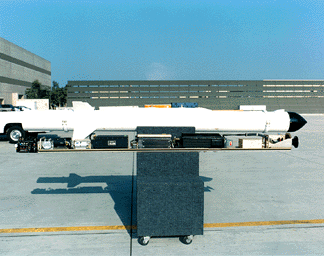
AST-6 Radar Emissions Simulating Set



The AN/AST-6(V) (AST-6) Radar Emission Simulating Set (RESS) is an active airborne radar emitter designed to present effective simulations of the newest and most complex hostile, antiship missile threats. The system consists of one or more simulator assemblies (pods), the universal control box (UCB) and interfacing cable assemblies. The pods may be either wing or fuselage mounted on subsonic or supersonic aircraft. The pod is controlled by the cockpit mounted CI to provide real-time control during flight. Up to four pods can be installed on a single aircraft and controlled through a single CI. Installing extender modules in the CI increases the pod carriage number to twelve.
Threat simulation is accomplished by producing the same radio frequency (RF), RF pulse repetition frequency (PRF), and RF pulse widths (PW) as the designated threat. The scan of the designated threat is simulated by turning the RF transmissions on and off at specific intervals. The AST-6 RESS simulates the progressive stages of a given threat by executing an onboard stored program called a scenario. A scenario is a sequence of commands for the specific RF, PRF rate, PRF mode (steady, jitter, or staggered), PW value, scan on or scan off, and (if scan on) interval and group width of the pulse streams that defines a given threat transmitter configuration. These scenarios can be programmed to run sequentially (utilizing jump commands) to simulate search, launch, and terminal modes in a time frame that represents an actual missile threat.
A total of 98 scenarios can be loaded into the AST-6 digital computer, but only one scenario can be run at a time. The digital computer is located in the aft section of the equipment tray and provides communication between the remote UCB and the other tray-mounted assemblies. It decodes digital commands from the UCB and controls the execution of the preprogrammed scenarios which are stored in the EEPROM chip within the digital computer. The digital computer also monitors system faults and provides communication between the pod and the USM-641 test set during testing and troubleshooting procedures. Parameter control flexibility was incorporated in the pod to permit parameter changes in PRF, PW, and RF amplitude modulation during a mission. In flight parameter changes permit the use of a single transmitter to produce time-sequenced threat signals. Threat simulations are created using the on board AN/UPT-2A Radar Transmitting Set fitted with one of a variety of manual and automatic tuner assemblies to provide RF control.

AST-6 Radar Emissions Simulating Set